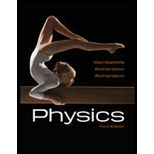
(a)
Find the equivalent resistance between point A and B.
(a)
Answer to Problem 52P
The equivalent resistance between point A and B is
Explanation of Solution
The sum of individual resistance connected in series and reciprocal of resistance connected in parallel will give the equivalent resistance.
From the given circuit, consider left
The resistor
This resistance is in series with
The resistance
The equivalent resistance
This resistance is in series with
Substitute the values of
Conclusion:
Substitute
Therefore, the equivalent resistance between point A and B is
(b)
Find the current through the resistor of resistance
(b)
Answer to Problem 52P
The current through the resistor of resistance
Explanation of Solution
Write the equation for current from emf.
Here,
Conclusion:
Substitute
Therefore, the current through the resistor of resistance
(c)
Find the current through the resistor of resistance
(c)
Answer to Problem 52P
The current through the resistor of resistance
Explanation of Solution
The potential difference across the equivalent resistance
Then the potential difference across the equivalent resistance
Conclusion:
Therefore, the current through the resistor of resistance
Want to see more full solutions like this?
Chapter 18 Solutions
Physics
 College PhysicsPhysicsISBN:9781305952300Author:Raymond A. Serway, Chris VuillePublisher:Cengage Learning
College PhysicsPhysicsISBN:9781305952300Author:Raymond A. Serway, Chris VuillePublisher:Cengage Learning University Physics (14th Edition)PhysicsISBN:9780133969290Author:Hugh D. Young, Roger A. FreedmanPublisher:PEARSON
University Physics (14th Edition)PhysicsISBN:9780133969290Author:Hugh D. Young, Roger A. FreedmanPublisher:PEARSON Introduction To Quantum MechanicsPhysicsISBN:9781107189638Author:Griffiths, David J., Schroeter, Darrell F.Publisher:Cambridge University Press
Introduction To Quantum MechanicsPhysicsISBN:9781107189638Author:Griffiths, David J., Schroeter, Darrell F.Publisher:Cambridge University Press Physics for Scientists and EngineersPhysicsISBN:9781337553278Author:Raymond A. Serway, John W. JewettPublisher:Cengage Learning
Physics for Scientists and EngineersPhysicsISBN:9781337553278Author:Raymond A. Serway, John W. JewettPublisher:Cengage Learning Lecture- Tutorials for Introductory AstronomyPhysicsISBN:9780321820464Author:Edward E. Prather, Tim P. Slater, Jeff P. Adams, Gina BrissendenPublisher:Addison-Wesley
Lecture- Tutorials for Introductory AstronomyPhysicsISBN:9780321820464Author:Edward E. Prather, Tim P. Slater, Jeff P. Adams, Gina BrissendenPublisher:Addison-Wesley College Physics: A Strategic Approach (4th Editio...PhysicsISBN:9780134609034Author:Randall D. Knight (Professor Emeritus), Brian Jones, Stuart FieldPublisher:PEARSON
College Physics: A Strategic Approach (4th Editio...PhysicsISBN:9780134609034Author:Randall D. Knight (Professor Emeritus), Brian Jones, Stuart FieldPublisher:PEARSON





